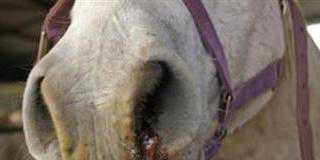White line disease used TO be known as “seedy toe”, but the name was changed because it can also affect other parts of the hoof wall, including the sides and heels. In mild cases there are few symptoms and the horse isn’t lame, but the infection can spread upwards and inwards and ultimately cause severe lameness and destruction of the underlying structures.The hoof wall, which is the outside of an equine hoof, has three layers. The first of these is the periople, a smooth, shiny layer that’s unfortunately often sanded off when horses are prepared for show. This waterproof layer protects the hoof from excess moisture or from drying out. Removing it makes the hoof more prone to cracks and infections, which can lead to white line disease. The second and third layers of the hoof wall are much thicker and a thin white line separates the wall from the sole. White line disease doesn’t affect the white line – it only affects the hoof wall. Instead of being solid, the hoof wall disintegrates into a powdery white substance that’s easily scraped away. This is differentiated from footrot, where a greasy, bad smelling exudate is seen in the sulci of the frog and heels. There’s often a hollow sound when the affected portion of the hoof wall is lightly tapped with a hammer. Sometimes the hoof wall separates from the underlying white line, and this can be seen during routine “picking out” of the hooves, when mud and manure is scraped away from the sole.
Causes and symptoms
White line disease is mainly caused by a fungus, but the bacteria associated with footrot can also be involved. The entry point for the fungi and bacteria is often a break in the hoof wall, resulting from galloping over uneven ground, a stone in the foot, or a crack caused by overlong hooves. Hooves that wear unevenly, a club foot or under-run heels can also cause hoof wall injuries. Sheared heels occur when one side of the foot is longer than the other and the bulbs at the back of the foot separate, causing a deep fissure, which can also become infected with bacteria. Bad stable yard conditions can also contribute to white line disease. Dry sand can dehydrate the hoof wall, making it prone to cracking. Extremely wet conditions soften the hoof wall, allowing microorganisms to enter, as mud, manure and gravel pack into any cracks that occur.If not diagnosed early, white line disease can result in malformed hooves. For example, there’s “slipper hoof”, where the hoof grows forward and turns up at the end, like a lady’s slipper. The disease can also result in flat feet with under-run heels. In advanced cases, the infection moves from the hoof wall to the laminae, causing laminitis. If a horse with white line disease is lame, consult a veterinarian immediately.
Prevention and treatment
Good foot management is the key to prevention. Working horses should have their feet “picked out” twice a day and carefully examined for stones or cracks in the hoof wall. Horses kept outside, such as broodmares, should have a general check up at least once a week. Putting sand or sawdust on walkways and under gates is essential as white line disease is often associated with wet conditions. The old-fashioned practice of coating the hoof soles with Stockholm tar after picking out is also effective in preventing white line disease as it’s antibacterial and antifungal. Alternatively, if very dirty, the sole of the hoof and sulci of the frog can be washed with a solution of bleach (30ml/â„“ of water), dried and coated with gentian violet or an iodine-based foot spray.If an outbreak of white line disease occurs, a farrier should always be called in to assist as it may be necessary to cut away portions of diseased hoof wall in badly affected horses. The hoof wall may even need to be artificially built up to protect the sensitive structures underneath. If these structures are already compromised and the horse is lame, you must consult a veterinarian, as the horse will need extensive remedial treatment.
E-mail Dr Mac c/o
[email protected]. |fw













